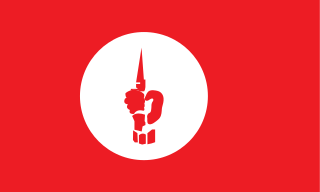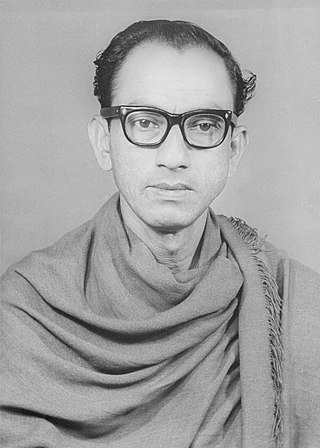
Sheikh Mujibur Rahman, also known by the honorific Bangabandhu, was a Bangladeshi politician, revolutionary, statesman, activist and diarist, who was the founding leader of Bangladesh. As the leader of Bangladesh, he had held continuous positions either as Bangladesh's president or as its prime minister from April 1971 until his assassination in August 1975. His nationalist ideology, socio-political theories, and political doctrines are collectively known as Mujibism.
The Bangladesh Krishak Sramik Awami League was a political front comprising the Bangladesh Awami League, the Communist Party of Bangladesh, the National Awami Party (Muzaffar) and Bangladesh Jatiya League.

Sheikh Mujibur Rahman, the first president of Bangladesh, was assassinated along with most of his family members during the early hours of 15 August 1975 by a group of Bangladesh Army personnel who invaded his residence as part of a coup d'état. The Minister of Commerce, Khondaker Mostaq Ahmad, immediately took control and proclaimed himself head of an interim government from 15 August to 6 November 1975; he was in turn succeeded by Chief Justice Abu Sayem. The assassination marked the first direct military intervention in Bangladesh's civilian administration. Lawrence Lifschultz characterized this incident as an outcome of the Cold War between the United States-influenced Pakistan and the Soviet Union-influenced India. 15 August is annually observed as National Mourning Day, a commemorative day in Bangladesh.

The Jatiya Samajtantrik Dal is a political party in Bangladesh. The party was founded by Serajul Alam Khan. The party was dominant during the 1972–1975 Bangladesh insurgency. The current party president is Hasanul Haque Inu, and the general secretary is Nazmul Haq Prodhan.
Sheikh Fazlul Haque Moni was a Bangladeshi politician. He was one of the nephews of Sheikh Mujibur Rahman, the founding father of Bangladesh. He was the founder of Mujib Bahini Bangladesh Liberation Force-BLF one of the major guerrilla forces of the Bangladesh Liberation War and also the founder of Bangladesh Awami Jubo League, the youth wing of Bangladesh Awami League.
The Mujib Bahini, also known as Bangladesh Liberation Force (BLF), was an armed force formed during the Bangladesh Liberation War to fight against Pakistan in 1971. The force was mainly composed of activists drawn from the Awami League and its student front, the Chhatra League. At its height, it had reportedly 10,000 members. It was organised with the active assistance of Major General Sujan Singh Uban of the Indian Army and Research and Analysis Wing. Serajul Alam Khan and Sheikh Fazlul Haque Mani, Tofael Ahmed and Abdur Razzaq were the organizers of this force.

Gonobahini was the armed wing of the Jatiya Samajtantrik Dal. The group was mainly composed of former Mukti Bahini members from the 1971 Bangladesh Liberation War.

The Mukti Bahini, also known as the Bangladesh Forces, was the guerrilla resistance movement consisting of the Bangladeshi military, paramilitary and civilians during the Bangladesh Liberation War that transformed East Pakistan into Bangladesh in 1971. They were initially called the Mukti Fauj.
The 1974 Ramna Massacre was a massacre of Jatiya Samajtantrik Dal (JASAD) supporters that took place on March 17, 1974. The incident took place when a group of demonstrators from the Jatiya Samajtantrik Dal, who were blockading the residence of the Home Minister Mansur Ali, located in the Ramna area of Dhaka, was fired upon by members of Jatiya Rakkhi Bahini. The incident reportedly claimed at least twelve lives.
Lal Bahini, was the armed wing of Bangladesh Awami League's labour front Bangladesh Jatio Sramik League, that was active during 1972 to 1975 until the Assassination of Sheikh Mujibur Rahman on August 15, 1975. Lal Bahini was headed by Bangladesh Jatio Sramik League President Abdul Mannan. The force was basically a vanguard of the then Bangladesh Awami League and was used to suppress uprising among the workers.
Nizam Mohammad Serajul Alam Khan, commonly known as Serajul Alam Khan, also called as Dada, Dadabhai and by his initials SAK, was a Bangladeshi politician, political analyst, philosopher and writer who spearheaded the Bangladesh liberation movement under the leadership of Sheikh Mujibur Rahman but also became one of the controlling forces of political polarization in post-independence Bangladesh.
Second Revolution was a political hypothesis presented by the "founding father" of Bangladesh, Sheikh Mujibur Rahman. The hypothesis included a series of reforms in the three pillars of a state: administrative, judiciary and legislative systems. The reforms were enacted through the fourth amendment to the constitution of Bangladesh. BaKSAL was formed as the decision making council to carry out the revolution.
Committee for Civil Liberties and Legal Aid in short Civil Liberties Committee was a forum in Bangladesh formed by the members of civil society to restore the civil liberties and provide legal aid to the dissenting population of the country who were the victims of Jatiya Rakkhi Bahini. Headed by eminent poet Sikandar Abu Zafar, the committee consisted a total of 33 members.

1972–1975 Bangladesh insurgency refers to the period after the independence of Bangladesh when left-wing insurgents, particularly the Gonobahini fought against the government of the Prime Minister Sheikh Mujibur Rahman. The government responded by forming the Jatiya Rakkhi Bahini, which began a crackdown on the general populace. The force became involved in the numerous charges of human rights abuse including political killings, shooting by death squads, and large number of rapes on women. The insurgency was one of the main reasons for the fall of Sheikh Mujib.

The military coup in Bangladesh on August 15 of 1975 was launched by mid-ranking army officers in order to assassinate founding president Sheikh Mujibur Rahman, whose administration post-independence grew corrupt and reportedly authoritarian until he established a one-party state-based government led by the socialist party Bangladesh Krishak Sramik Awami League. Mujib, along with his resident family members, were killed during the coup but was survived by his two then-expat daughters, one of them being future prime minister Sheikh Hasina. The officers were led by Capt. Abdul Majed, Maj. Sayed Farooq Rahman, Maj. Khandaker Abdur Rashid and Maj. Shariful Haque Dalim.
The 3 November coup d'état was organised by Brig. Khaled Mosharraf against President Khondaker Mostaq Ahmad to remove him from the presidency and the assassins of Sheikh Mujibur Rahman from power: Capt. Abdul Majed, Maj. Syed Faruque Rahman, Maj. Khandaker Abdur Rashid and Maj. Shariful Haque Dalim. The coup resulted a return of Mujibist forces in Bangladeshi politics for a short time.

Mosharraf Hossain was a politician and lawyer from Jessore, Bangladesh. He was actively involved in the Bengali nationalist movement in East Pakistan and the Liberation War of Bangladesh in 1971.

The premiership of Sheikh Mujibur Rahman began on January 12 of 1972 when he was sworn in as the Prime minister after briefly serving as the President after returning from Pakistan's jail on January 10, 1972. He served as the Prime Minister of Bangladesh until January 25, 1975, for three years, and later led the parliament to adopt an amendment of the constitution that made him the President of Bangladesh, effectively for life.
Sabihuddin Ahmed was a Brigadier General of the Bangladesh Army. He has previously served in the Jatiya Rakkhi Bahini. He was the founding chairman of Bangladesh Rural Electrification Board, the largest power distribution company in Bangladesh.

Public criticisms of the Bangladesh Awami League include the Bangladesh Chhatra League, the Jubo League, the Swechchhasebak League, etc., as well as other bodies with which Awami League is overtly or allegedly involved, when they were in power or not. Notable examples include the Murder of Abrar Fahad, the Padma Bridge graft scandal, the Murder of Biswajit Das, the Murder of Sagar Sarowar and Meherun Runi, the Bangladesh Rifles revolt, the 2013 Shapla Square protests, the Bangladesh quota reform movement, the Violence of Bangladesh Chhatra League, the S Alam Group scandal, the Logi Boitha Movement, issues over disputed elections in 2009, 2014 and 2018, and the corruption at the Rooppur Nuclear Power Plant, etc.











